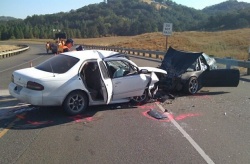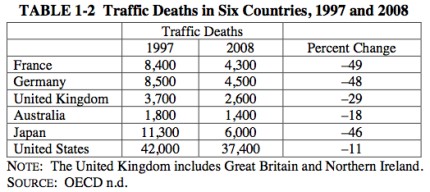
willing to accept the carnage.
(Photo: Oregon State Police)
A landmark, 186-page special report by the Transportation Research Board (TRB) published this week delivers a critique of U.S. traffic safety efforts and says that we have fallen way behind in saving lives relative to other nations. The report, Achieving Traffic Safety Goals in the United States: Lessons from Other Nations, was published by the National Academies Press and is available as a free PDF download.
“The gap between traffic safety progress in the United States and the other high-income countries… indicates that the United States may be missing important opportunities to reduce traffic deaths and injuries.”
To find strategies the U.S. might use to catch up, the TRB put together a committee to research and document the experience of other high-income nations and learn more about the programs they’ve used to improve traffic safety.
What they found is that in recent decades, nearly every other high-income country has made more rapid progress that the U.S. in reducing road traffic deaths and the rate of deaths per mile traveled. As a result, says the study’s preface,
“The United States can no longer claim to rank highly in road safety by world standards. The gap between traffic safety progress in the United States and the other high-income countries… indicates that the United States may be missing important opportunities to reduce traffic deaths and injuries.”
To put it into numbers, the study found that from 1995-2009, traffic fatalities dropped an average of 50 percent in 15 high-income countries (excluding the U.S.) where such statistics are kept; but in the U.S., fatalities have dropped by just 19 percent. Here’s a table taken from the study:

The report takes a comprehensive look at Australia, France, Sweden, and the United Kingdom and attempts to understand the how and why behind their successes. The TRB committee left no stone unturned, examining every possible component that could impact traffic safety, from cultural demographics and attitudes to enforcement strategies (or lack thereof), political and public support and economic cycles.
As you might expect, no silver bullet solution was found, but a general tone does seem to emerge. Check out this excerpt:
“The lack of progress in reducing the highway casualty toll might suggest that Americans have resigned themselves to this burden of deaths and injuries as the inevitable consequence of the mobility provided by the road system. In other countries, public officials responsible for the roads have declared that this human and economic cost is neither inevitable nor acceptable and have undertaken rigorous and innovative interventions to reduce crashes and casualties.”
This reminds us of the concept of “Vision Zero” that traffic safety consultant Peter Jacobsen spoke about in Portland recently (and which the TRB study also mentions at length).
The report is a fascinating read for transportation wonks and advocates. One section I found of particular interest was how the America socio-political environment is one big reason why we haven’t moved forward in making roads safer as quickly as other countries. Here’s an excerpt from a section titled, Lack of Political and Public Support:
“…State officials encounter public objection and interest group opposition to such measures as radar detectors, speed limit reductions, automatic speed and red light enforcement, helmet laws, seat belt laws, sobriety checkpoints, and reduced BAC limits.”
The report didn’t just detail the problems, it outlines recommendations about how the U.S. can solve it. Improved road design practices (roundabouts were mentioned a lot, as was the need to do road safety audits) and stepped up enforcement programs to gain control of speed and drunk driving were two of the key recommendations.
The Oregon Department of Transportation had a representative on the committee behind this report; Troy Costales, Manager of their Transportation Safety Division. I’m hoping to have a Q & A with Costales later today about this report and traffic safety in Oregon in general. Stay tuned for that.
For more coverage on the TRB report, check out stories on NPR and the Wall Street Journal. You can also download the report for free here.

